 Полная версия
Полная версияAmerican Pomology. Apples
Origin, Canton County, Illinois. Tree large, vigorous, productive, annual bearer.
Fruit large, globular-oblate, often oblique or unsymmetrical; Surface smooth, greenish-yellow, with a carmine blush; Dots minute, indented.
Basin abrupt, deep, folded; Eye medium to large, open.
Cavity deep, narrow or acute, green and brown; Stem rather long and slender.
Core small, round, clasping; Seeds numerous, small, short and plump; Flesh yellow, tender, line grained, juicy; flavor sub-acid and aromatic; First quality for table; In November and December. Our Illinois orchardists do not commend it so highly as when first introduced; not fully satisfactory where planted in Ohio on limestone clays.
Golden Seedling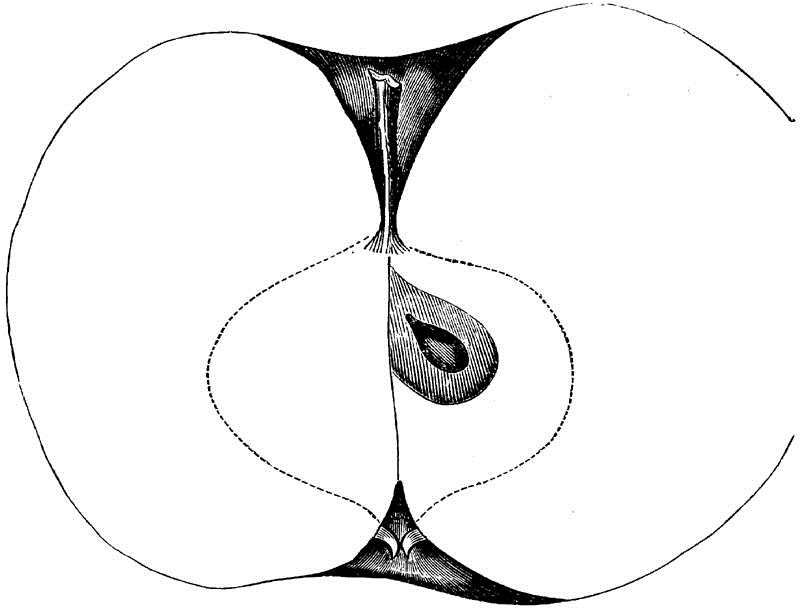
Fig. 73.—GOLDEN SEEDLING.
Said to have originated with Mr. Riehl, of St. Louis, cultivated and distributed by Geo. Husmann, of Hermann, Mo., in whose orchard I gathered it.
Fruit large, handsome, regular, and oblate; Surface smooth, greenish-yellow, and blushed; Dots scattered, minute.
Basin wide, regular; Eye medium, closed.
Cavity wide, wavy; Stem short.
Core medium, regular, meeting the eye, closed; Seeds numerous, angular, pale; Flesh yellow, juicy, rich; "Very good."
Green Crank
Fig. 74.—GREEN CRANK.
I have received this southern apple from Kentucky, Tenn., and also from Georgia, but have not yet fruited it. Tree moderately thrifty; Shoots brown; Foliage small.
Fruit medium to large, flattened somewhat, conical, regular; Surface green to yellow, sometimes bronzed; dots small, gray.
Basin medium, regular; Eye medium, closed.
Cavity wide, deep, acute, brown; Stem medium, green, thick.
Core wide, medium, closed, not clasping the eye; seeds numerous, plump, short, dark; Flesh yellow, firm, fine grained, juicy; Flavor sub-acid, aromatic, rich; Quality good to very good; Use table, kitchen; Season December to March.
Hawley
Fig. 75.—HAWLEY.
Originated in Columbia County, New York. Tree vigorous, with a round spreading head; Shoots stout, olive.
Fruit large, regular, oblate or slightly conic; Surface waxy yellow, rarely shaded or blushed, becomes oily or greasy when kept.
Basin rather wide, wavy; Cavity wide, sometimes folded; Stem short, medium and long.
Core regular, closed, scarcely clasping the eye; Seeds generally imperfect; Flesh yellowish-white, very tender, fine grained, juicy; Flavor very pleasant, mild sub-acid, rich; Season August to September; an amateur's fruit.
Hawthornden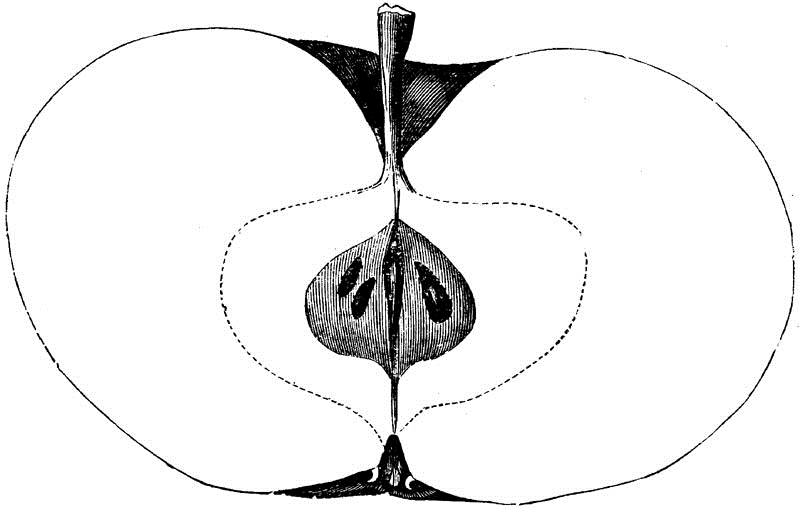
Fig. 76.—HAWTHORNDEN.
This famous Scotch fruit appears to do very well in this country, but it must yield the palm to its American cousin and representative, the Maiden's Blush, which possesses all its good qualities as a market and kitchen fruit, with attractive appearance.
Tree spreading, vigorous and productive; an early bearer.
Fruit large, regular, and very flat; Surface perfectly smooth, always fair, and of a beautiful white, very rarely and faintly blushed; Dots minute.
Basin shallow, narrow, regular; Eye small, closed.
Cavity wide, wavy, green; Stem medium.
Core wide, regular, somewhat open, meeting the eye; Seeds numerous, angular, imperfect, brown; Flesh greenish-white, breaking, fine grained, juicy; Flavor acid, aromatic; of second quality for table, but first rate for cooking; Uses, kitchen and market; Season October.
JunaliskaThis apple originated in the Cherokee country, where it is highly esteemed, and fruited in Ohio and Kentucky this year.
Fruit large, roundish, or flattened, slightly conic, regular; Surface smooth, yellow, with some russet, chiefly about the apex; sometimes blushed; Dots minute, gray.
Basin rather small, regular; Eye small, long, closed.
Cavity deep, acute, brown; Stem quite short, knobby.
Core wide, heart-shaped, regular, closed; Axis short; seeds few, short, plump; Flesh yellow, breaking, granular; flavor sub-acid, spicy, rich; Quality good; Use, table and kitchen; Season November, and through the winter.
It may be destined to supply the place of the Rhode Island Greening, where that variety does not succeed.
KaneCAINOrigin, Delaware. Tree upright, sufficiently vigorous. Has been confounded with the Bohanon, but is distinct.
Fruit small, regular, oblate, somewhat conic; Beautiful for the dessert; Surface very smooth, waxen yellow, blushed with bright crimson; Flesh whitish, crisp, juicy, acid and pleasant; October and November.
LadyAPI PETIT, ETCThis beautiful little French apple has been fully naturalized in our country, and has received the enthusiastic admiration of the American people. The fruit needs to be entirely perfect to meet with favor as an ornament to the table, for which use it is especially adapted; unfortunately it is often overgrown and irregularly developed. Wherever produced in proper size and color, it is one of the most profitable varieties, commanding fancy prices at the period of Christmas decorations. In the rich soils of the West it is apt to be too large, and has generally failed to meet the requisitions; but it succeeds well in Michigan, and the neighboring region of Indiana.
Tree of medium size, very close and upright, healthy and productive; Shoots very dark; the foliage small, crowded, curled, and very dark.
Fruit very small, quite flat, very regular; Surface very smooth, shining or polished, of a pale waxen yellow, nearly covered with bright carmine, which contrasts finely with the ground color, wherever the fruit has been shaded by a leaf; Dots minute.
Basin medium, rather abrupt; Eye small, closed.
Cavity acute, deep, regular; Stem short.
Core regular, wide, closed; Seeds numerous; Axis very short; Flesh white, breaking, tender and juicy when ripe; with a mild sub-acid flavor; Use ornament and dessert; Season December until March.
Maiden's Blush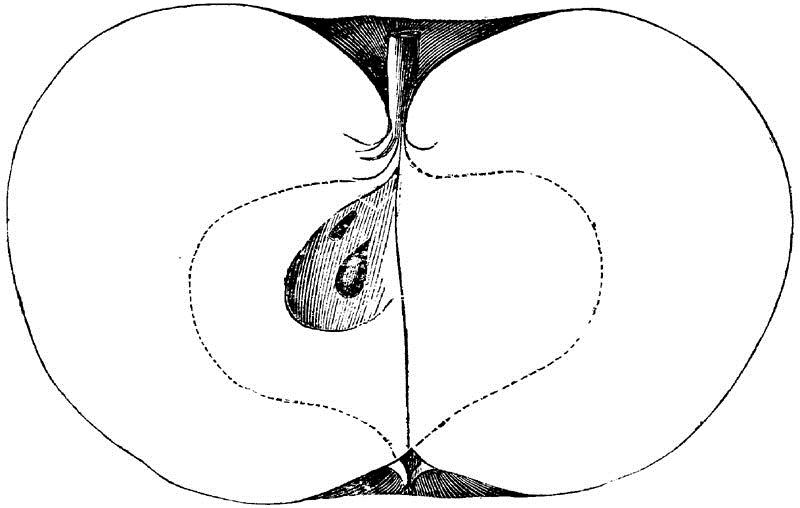
Fig. 77.—MAIDEN'S BLUSH.
This beautiful and profitable fruit has received the unqualified approbation of thirteen out of the eighteen States that have reported to the American Pomological Society. It is a native of New Jersey, and is still held in high repute there as a market apple. The tree is hardy, vigorous, spreading and productive, beginning to bear quite early.
Fruit medium, to large, regular, flat and very handsome; Surface very smooth, polished, of a pale waxen yellow and blushed with bright carmine; Dots minute.
Basin shallow, regular or wavy; Eye small, closed.
Cavity wide, wavy; Stem medium to short.
Core regular, closed, meeting the eye; Seeds numerous, brown; Flesh white, breaking, fine grained, juicy; Flavor acid, aromatic, and to most palates not agreeable at the dessert, but very good when cooked, and requiring but a short time to be reduced to a delicious pulp of light color. This apple is also used for drying and makes a very light colored product, that is much admired by dealers. Season September and October, but may be used in the kitchen during August.
Bachelor's Blush appears to be a variety of the above; found in Burlington County, New Jersey, and exhibited before the American Pomological Society at the Rochester meeting in 1864, by Wm. Parry, as a valuable, and distinct variety. Having examined the trees as they grew together in the orchard, the resemblance to Maiden's Blush was very apparent. The fruit is larger, and for market purposes is considered more profitable. The two may be different, but are very much alike.
Pickard's Reserve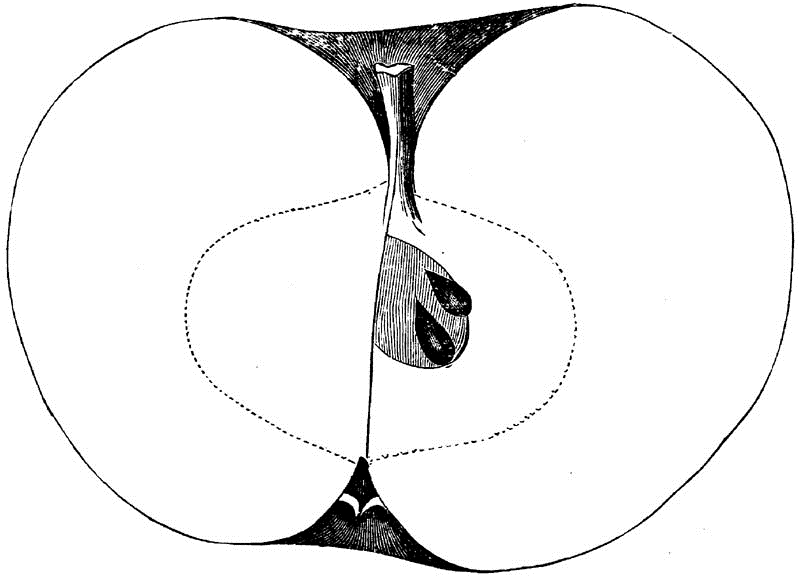
Fig. 78.—PICKARD'S RESERVE.
Grown in Parke County, Indiana, from seed brought from North Carolina. This apple was first brought to my notice by Jno. C. Teas, of Raysville, Indiana. Considerably grown in that State. Tree hardy; the original is still standing in Rockville.
Fruit large, flat, somewhat unequal; Surface smooth, pale yellow; Dots scattered, minute.
Basin abrupt, regular, rather deep; Eye quite small, closed.
Cavity deep, wavy, brown; Stem short to medium.
Core irregular, closed, scarcely clasping the eye; Seeds numerous, angular, dark brown; Flesh whitish-yellow, fine grained, tender, juicy, with a sub-acid, aromatic flavor, making this a fruit of first quality for table or kitchen use; Season December and January.
Rhode Island Greening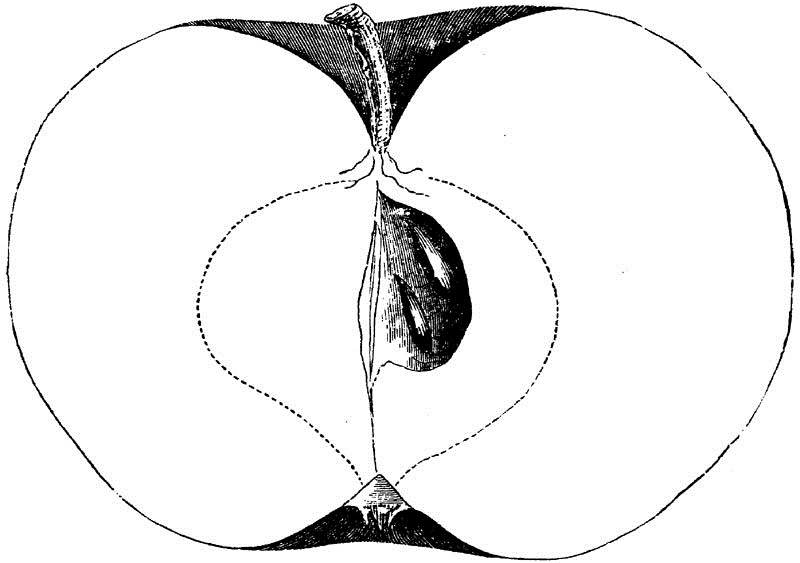
Fig. 79.—RHODE ISLAND GREENING.
From its name this apple would appear, like the Peck's Pleasant, to have come from the sea-girt State. It is a universal favorite, and is found to succeed well in a great many situations; but there are some portions of the West where it has failed to give satisfaction, being slow to come into bearing, becoming an autumn instead of a winter fruit, and falling badly from the trees before picking time. In sandstone soils, however, even in Southern Indiana and Illinois, it does better than on the limestone clays; the fruit attains an enormous size, but matures too early for a winter apple.
Tree very vigorous, crooked, spreading, productive; Shoots stout, dark, with dark foliage.
Fruit large to very large, varying in shape from globular or round to flat, which is the prevailing and characteristic form. Surface smooth in the North, somewhat rough and often quite russeted in the South, a dull green, becoming yellow at maturity; Dots grey, irregular, numerous.
Basin regular, small and russeted to a greater or less extent, sometimes extending half way down the sides of the fruit; Eye small to medium, closed.
Cavity wide, regular; Stem medium to long, curved, often reddish.
Core roundish-oval, regular, closed, clasping the eye; seeds numerous, angular, dark; Flesh very yellow, breaking, tender, juicy, with a rich, acid flavor, making it a superior cooking apple, and very fine for the dessert when fully ripe; Quality almost first rate; Season October to December—in the North, keeping until March.
Tewksbury Winter BlushThis long-keeping variety was described by Coxe as having its origin in New Jersey. It has already been named in connection with the Fink, which resembles it very closely, and, like it, the chief excellence of this variety consists in its superior keeping qualities.
The tree is vigorous, upright, productive, and holds the apples well.
Fruit small, regular, flat; Surface smooth, yellow, blushed; Flesh yellow, breaking, juicy, well flavored, and retains its characters for a long time.
Virginia Greening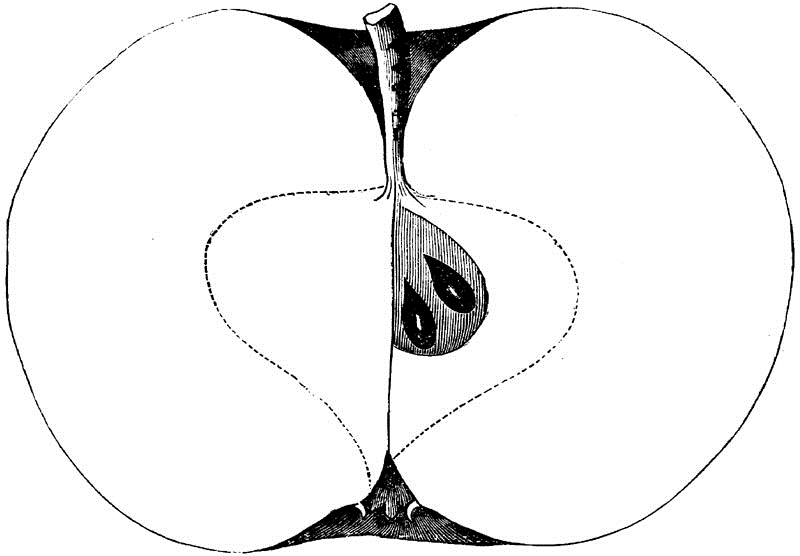
Fig. 80.—VIRGINIA GREENING.
This apple is supposed from its name to have originated in Virginia. It is cultivated chiefly in the Southern States, and in those parts of the Northwest to which Southerners have migrated. Its chief merit is its long keeping. Tree large, spreading, productive.
Fruit large, regular, flat to roundish, generally the former; Surface smooth, dull green and often bronzy, never blushed; Dots scattered, large, white or gray, with whitish rings around them.
Basin regular, wide, shallow; Eye small, open.
Cavity wide, regular, green; Stem long to medium.
Core regular, turbinate, closed, meeting the eye; Seeds numerous, long; Flesh white, firm, breaking, sub-acid; Fit only for the kitchen; A long keeper; March and April; often subject to Bitter-rot.
White Fall PippinFALL PIPPIN OF LOUISVILLEThis handsome fruit is seen in quantities in the Louisville market every fall. Its cultivation does not appear to have been widely extended, nor has its origin been traced. It has been thought to resemble the Spanish Reinette, with which I have not had an opportunity to compare it.
Fruit very large, slightly uneven, roundish-flattened or globular-oblate; Surface smooth, pale yellow, not bronzed or blushed, but having a whitish striping toward the stem end; Dots scattered, minute, dark.
Basin abrupt, narrow, deep and folded; Eye small, long, closed.
Cavity wide, wavy; Stem very short.
Core wide, regular, somewhat open, clasping the eye; Seeds numerous, angular; Flesh yellowish-white, breaking, juicy; Flavor sub-acid, aromatic and rich; Useful for cooking, drying, and table; Season October.
White JuneatingJUNEATING, Coxe.—YELLOW JUNE.—EARLY MAY?Downing thinks this a very old variety, mentioned by Evelyn in 1660, and by Ray in 1688. It has long been known in the West and South as a very early apple, and valued on this account, though quite small. The tree resembles that of the Early Harvest in the color and arrangement of its twigs.
Fruit flat, regular; Surface smooth, pale yellow.
Basin not deep, slightly folded; Eye small, closed.
Cavity wide, shallow; Stem long, slender.
Flesh breaking, whitish, juicy till over-ripe, when it is dry; Flavor sub-acid; Use table and market; Season June.
Winter PippinWINTER PIPPIN OF GENEVAThis very handsome fruit was received from T.T. Lyon, of Plymouth, Michigan, marked as having been received from Western New York. The same fruit was a very strong competitor for the Greeley prize before the Committee of the American Institute, and is believed to be the same as that described by Downing as the Winter Pippin of Geneva.
Tree thrifty, branches spreading; Said to be productive.
Fruit large, oblate, regular, or slightly unequal; Surface smooth, pale yellow, with a bright crimson cheek; Dots numerous, minute.
Basin wide, wavy, or plaited; Eye medium, closed.
Cavity regular, green, rather deep; Stem long.
Core medium, regular, closed, clasping the eye; Seeds numerous, plump; Flesh yellowish-white, fine grained, juicy, sub-acid; Season January until May. A limited acquaintance does not justify me in giving such high praises as those bestowed upon this fruit by Mr. Downing.
Yellow Foster
Fig. 81.—YELLOW FOSTER.
This apple is a favorite with that worthy pioneer Pomologist of Southern Ohio, H.N. Gillett, of Lawrence County, to whom I am under obligations for this and many other varieties.
Fruit medium to large, regular, oblate; Surface smooth, greenish-yellow; Dots scattered, minute green.
Basin of medium depth and size, regular; Eye small, closed.
Cavity acute, regular; Stem of medium size and length.
Core medium, wide, closed, not meeting the eye; Seeds not numerous, medium; Flesh yellow, fine grained, tender, juicy; Flavor sub-acid and aromatic; Of first quality for table; During October.
CLASS I.—FLAT APPLESORDER I.—REGULARSECTION 2.—SOURSUB-SECTION 2.—STRIPEDAbramFATHER ABRAHAM, of Illinois, not that of CoxeThis little southern favorite is not extensively cultivated in the North, except where southern settlers have introduced it. It is found in Illinois, Indiana and Missouri. Origin believed to have been in Virginia, whence I have received specimens and trees. In Kentucky it is found to be a hardy drooping tree, holding the fruit well; annually productive, valued for cider, and keeping till July of next year.
Fruit medium, globular-oblate, uneven; Surface not smooth, yellowish green, mixed, red, with stripes and splashes; the whole presenting a gray appearance; Dots minute, scattered.
Basin shallow, wide, wavy; Eye small, closed.
Cavity acute, regular; Stem long, inclined.
Core medium, regular, closed; Seeds numerous, short, plump, pale; Flesh greenish-yellow, fine grained, juicy; flavor mild sub-acid, rich; almost first quality; keeping until May or later.
American PippinGRINDSTONEThis fruit is chiefly valued for keeping very late into the summer. Coxe commends it for its cider, rating it as nearly equal to the Grey-House; he says that fourteen bushels are required to make a barrel of cider. The apples hang well to the tree, and will bear a considerable amount of freezing. They are so firm as to suffer little from bruising, and are not disposed to rot when thus injured. A fruitman once said of their ability to withstand rough usage, that the apples might be whipped off the tree with a hoop-pole, shoveled into a cart, dumped upon the ground, and have some dirt thrown upon them, and that they would keep until next July; but, he added, they are then as good as dried apples; so lightly are they esteemed for table use.
The tree is thrifty, with a low, spreading head and depending branches; very productive; notwithstanding the fruit is dry and deficient in flavor, it is considered profitable, because so easily kept until May and June, when it commands the highest price, because of the rarity of green fruit at that season.
Fruit medium, regular, very flat; Surface rough, sometimes vein-russeted, dull green, covered with mixed red, and shaded with stripes of brick-dust color; Dots numerous, large, gray.
Basin very shallow, wide, regular or plaited; Eye quite small, open.
Cavity regular, brown, this color extending over the base of the fruit; Stem medium, often thick and knobby.
Core wide, irregular, closed; Seeds numerous, plump, brown; Flesh yellow, breaking, dry, very firm; Flavor mild sub-acid; Quality poor; Uses kitchen and market, which last means that it may be sold to those who do not appreciate the summer fruits of May and June.
Baldwin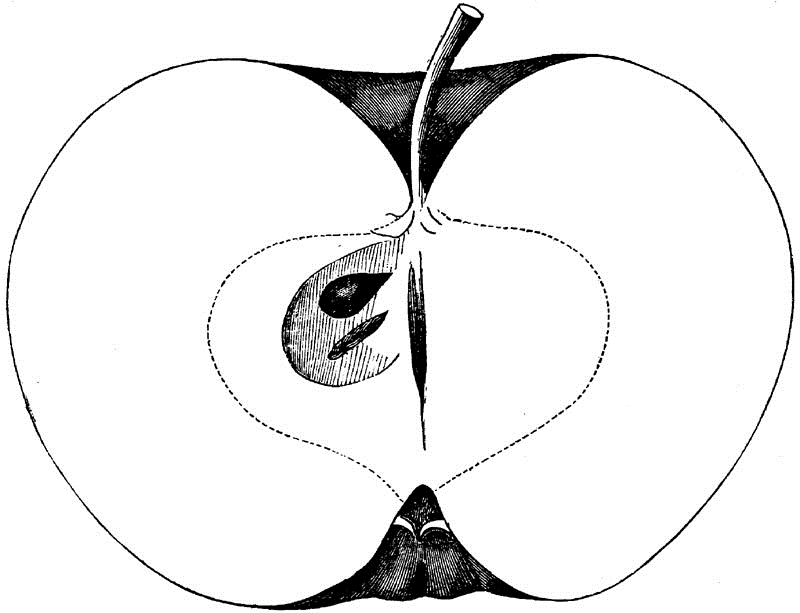
Fig. 82.—BALDWIN.
This celebrated apple of New England has been widely distributed over the country, but has not met with universal favor in the West and South; first, because it is apt to become a fall or early winter fruit, instead of a keeping apple; and secondly, because it is not well adapted to our palates; moreover, the tree has been considered tender, having suffered extensively during the cold winters; this is especially true in the nursery. Its productiveness and fair quality will, however, always make the Baldwin a favorite over a large portion of our country, and the New England settlers must have this variety.
Tree robust, spreading, very productive; Foliage large, dark, on shoots that are stout and have a rich brown bark.
Fruit large, frequently round, and sometimes almost conical, but generally inclined to be flattened, so as to be classed by measurement as oblate; large specimens in southern latitudes are very apt to be unequal, and to have their axis inclined, or to be what is called lop-sided; surface smooth, rich yellow where shaded, but the exposed parts quite covered with deep red, which is mixed so as to conceal the ground color, and also to obscure the stripes of deeper red that prevail; this fruit is also frequently marked with veined russet, overlying the red color, or excluding it; Dots minute, and yellow, or gray where the red prevails.
Basin deep, often abrupt and narrow, generally waved, folded or plaited, and these marks are quite characteristic; Eye large and open, from the shortness of the calyx. On this account the variety is considered very subject to the attacks of the Codling-moth.
Cavity wide, regular or wavy, generally brown; Stem medium to long, often curved or inclined, sufficiently stout.
Core medium, regular, closed, meeting, sometimes clasping the eye; Seeds numerous, long, angular, imperfect; flesh yellow, breaking, frequently coarse-grained, juicy, sub-acid, rich; some northern specimens are fine-grained and almost first quality; those from the South are coarse, poor and scarcely second-rate for table use, but are good for cooking; Season October to January, occasionally keeping later.
Bethlemite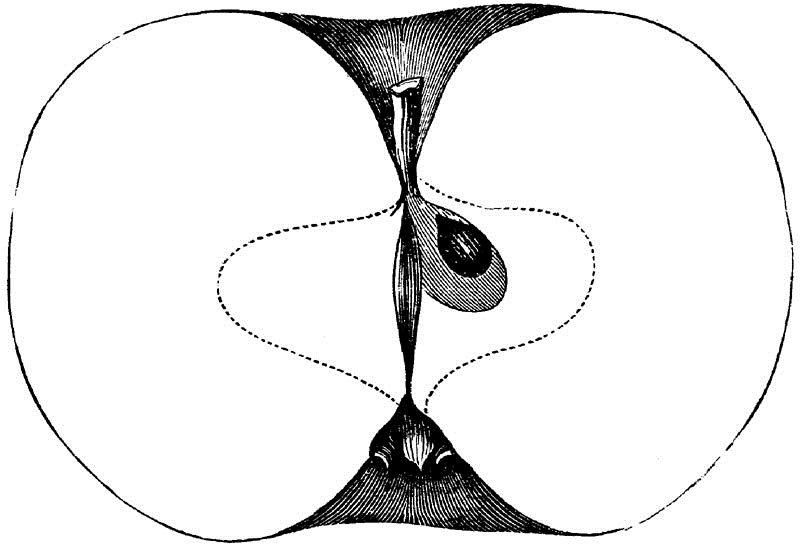
Fig. 83.—BETHLEMITE.
This apple has frequently been exhibited before the Ohio Pomological Society, by friends Lipsey, Morris and Benedict, of Morrow County, to which region its cultivation appears to have been confined. The origin of the fruit is obscure.
Tree thrifty, hardy, productive, upright.
Fruit medium, flat, or oblate-globular, regular; surface smooth, dull red or bright red, mixed, on yellow, with broken splashes of crimson; Dots distinct, large, gray and yellow.
Basin wide, deep, regular or folded, leather-cracked; Eye medium, closed.
Cavity rather wide, regular, brown; Stem medium to short.
Core regular, neat, closed, just meeting the eye; Axis short; Seeds numerous, short, very plump, pale; Flesh yellowish-white, breaking, juicy, sub-acid, aromatic; Quality good, for table and cooking; Season December.
Blondin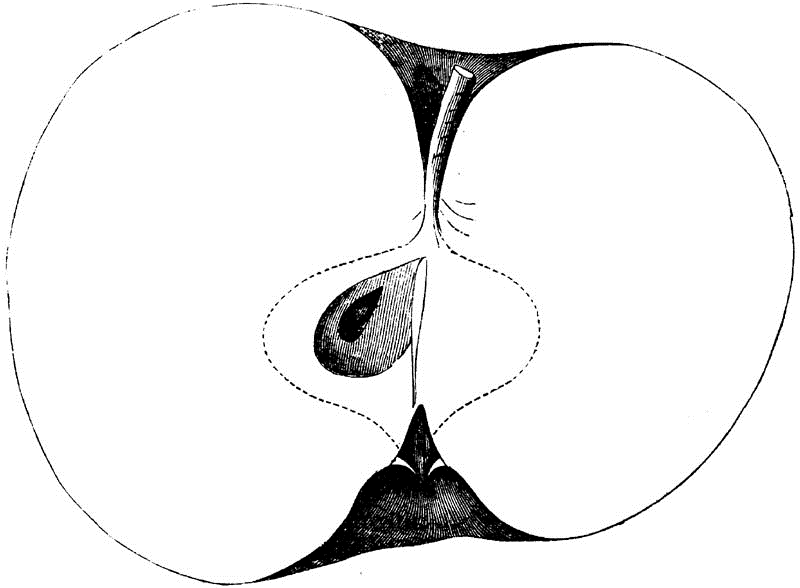
Fig. 84.—BLONDIN.
This fine fruit originated with the veteran Pomologist of Indiana, Reuben Ragan.
Fruit very large, oblate, unequal; Surface rough, greenish-yellow, splashed and striped with red; Dots numerous, large, gray.
Basin abrupt, folded; Eye small, closed.
Cavity acute, deep, brown; Stem short, rather slender inclined.
Core medium or small, regular, closed, clasping the eye; Seeds plump, pointed, brown; Flesh greenish-yellow, fine-grained, tender, juicy; Flavor sub-acid; almost first rate for table and market; Season October and November.
Blooming OrangeMr. Waring considers this the handsomest apple. In 1839 he brought a large number of sorts from the famous Herefordshire apple orchards of England, of which this is the only one he retains as fully adapted to the mountain region of Pennsylvania.
Tree a very strong, free, handsome grower, and an immense bearer, after six or eight years' growth.
Fruit very large, fair, beautiful, roundish-oblate, regular; surface dark, richly clouded with claret and mahogany, on yellow ground; Eye open; Flesh crisp, juicy, acid at first, but this merges into a rich, penetrating, very agreeable flavor.
It is of the Ribston Pippin, or Dutch Mignonne type of fruit.—[Mr. G. Waring's MS.]
BonumMAGNUM BONUM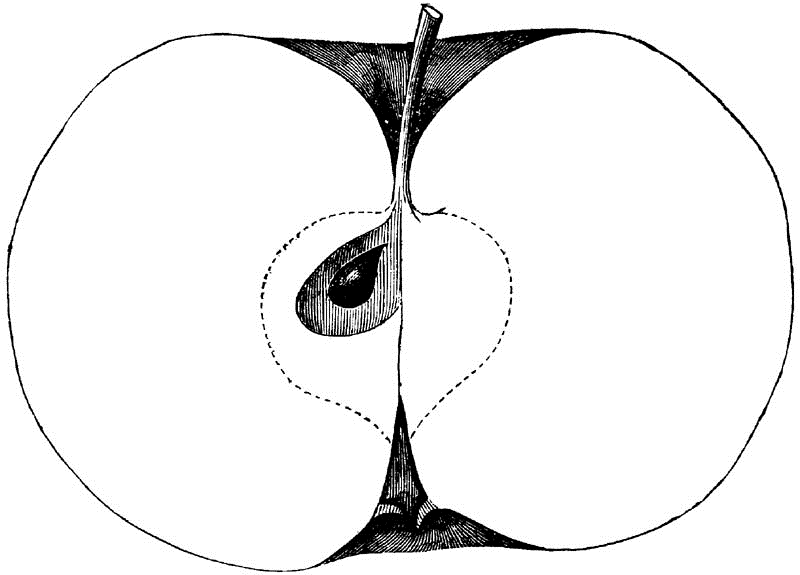
Fig. 85.—BONUM.
This delicious southern fruit originated in Davidson County, North Carolina. The tree is vigorous, very productive and bears early. I received specimens from S.W. Westbrooke, Greensboro', North Carolina. Introduced to the American Pomological Society at the Philadelphia meeting, 1860, by Walter Steele, of Rockingham County, North Carolina, and highly recommended.
Fruit large, oblate, regular; Surface smooth, yellow, covered with mixed red, and striped; Dots distinct, large, yellow.
Basin medium, regular; Eye large, closed.
Cavity deep, regular, brown; Stem long, not thick, green.
Core oval, small, closed, scarcely meeting the eye; Axis short; Seeds large, plump; Flesh yellow, firm, breaking, fine-grained, juicy; Flavor rich, sub-acid; first quality for the dessert; in September.
Brandywine
Fig. 86.—BRANDYWINE.
This apple was found on the edge of the prairie, east of Quincy, Illinois, in the orchard of K.K. Jones, Esq., where it was supposed to have been brought from the State of Delaware.
Tree large, vigorous, spreading and productive.
Fruit medium, oblate, roundish, slightly conic, regular; surface smooth, greenish, covered with confused stripes of dull red; Dots scattered, white.
Basin shallow, abrupt, regular; Eye small, closed.
Cavity acute, regular, green; Stem very short.
Core small, round, closed, clasping; Seeds imperfect; Flesh greenish-white, fine-grained, tender, juicy; Flavor sub-acid, aromatic; Quality only good; Use table, kitchen; Season January, February.
Buchanan'sOrigin near Cincinnati, Ohio, in the orchard of Robert Buchanan, Esq., a gentleman long devoted to pomology. It also closely resembles the Brandywine, as grown in Illinois, already described.



